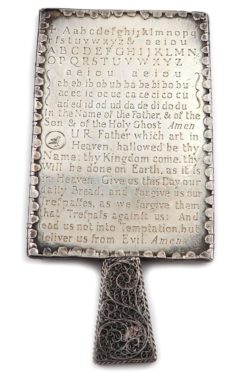The Salisbury saleroom Woolley & Wallis has taken a stunning £8,500 for a rare 17th Century silver-mounted ‘horn book’.
Circa 1690, with foliate scroll filigree decoration and a tapering handle, the ‘book’ was inset with a panel of the alphabet letters and the Lord’s prayer. It measured just 4½ inches, so I imagine it was once held by tiny hands, while read and recited by candlelight.
Horn books and the printed word share ancestry. They were introduced when printing with moveable type was popularised in Britain around 1450.
The first school books
They were the first school books, a child’s means of learning the alphabet, prayers and smatterings of literature. As such they are objects of bygone obscurity, unfamiliar to us now, and seldom seen, even in the antiques world.
Strictly speaking they were not books, but pieces of wood shaped like a dressing-table hand mirror. On their broad part was laid a sheet of written or printed parchment or paper and over this the transparent sheet of a horn was placed, hence the name.
Generally, there was a handle to hold it by, which often had a string, whereby the ‘book’ could be tied to a pupil’s waist or desk.
The very earliest examples sometimes featured a cross at the beginning of the text to remind the child to make the sign of the cross before starting a lesson.
The reverse often showed a pattern, perhaps a saint or member of the royal family.
Scottish horn books are rarer still. An example printed by ‘E. Raban, Aberdene’ and carrying the date 1620, was offered at Sotheby’s in 1879.
It was bought by the British Museum for £15.










